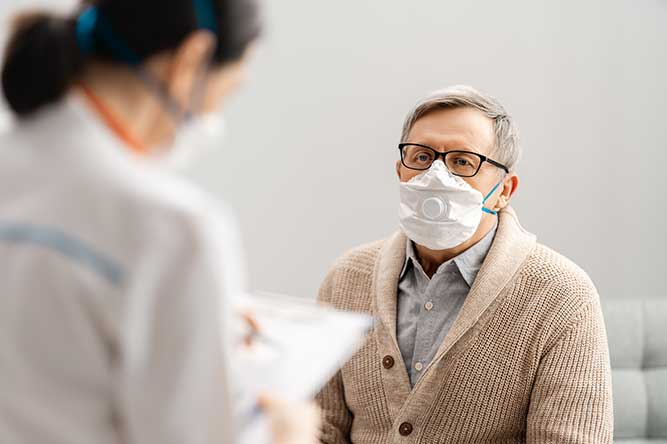
America was introduced to the COVID-19 pandemic through an outbreak in a nursing home in Kirkland, Washington, where over 30 residents died in March after contracting the deadly disease. From there, we learned that COVID-19 is a rare mix of an easy transmission and lethal impact, especially for the elderly and those with underlying conditions. Based on frightening projections that hospitals could potentially be overrun in certain hot spots, the attention of state and federal policymakers rapidly shifted away from long-term care (LTC) to finding ventilators, preserving hospitals’ intensive care capacity, acquiring personal protective equipment (PPE), ramping up testing, and implementing social distancing in order to “flatten the curve.” Now, several months into the pandemic, attention has squarely shifted back to long-term care.
The experiences of hard-hit states, such as New York, New Jersey, and Connecticut, are instructive as to why. In those states, there are both a high number and a large percentage of deaths related to COVID-19 occurring in LTC facilities, upwards of 50 percent in some cases. Other states are also seeing a high percentage (e.g., almost 80 percent in Minnesota) of total deaths occurring in nursing homes, though at lower total numbers than the hard-hit states.
Public policies toward LTC providers have been the subject of much controversy, centering on questions about communication with families and, in the case of several hard-hit states, policies around mandatory admission of COVID-19 patients. In turn, LTC providers in those states and across the country have repeatedly been raising urgent concerns about lack of PPE and availability of testing, as well as lack of alternative placement options during outbreaks.
Federal and state policy changes have ensued, such as visitor limitations, waivers of rules, and mandatory reporting to the Centers for Disease Control and Prevention (CDC), along with investigations by state attorneys general. In several states, the National Guard was called in to assist some facilities in performing non-clinical tasks. New York has recently limited hospitals from sending patients positive for COVID-19 to nursing homes. Most recently, the federal government is “strongly recommending” to states that all nursing home residents be tested over a two-week period, and several states have committed to testing all staff and residents in LTC.
Challenges Ahead for Skilled Nursing and Senior Housing Providers
Though there is some good news about the virus trending down nationally and in some of the hot spots, the environment is likely to become even more challenging for skilled nursing, assisted living, and senior housing providers. This is likely to happen for multiple reasons.
Many states are moving towards reopening, whether in concert with CDC guidelines or not. This could increase the rates of infection, particularly among LTC staff and vendors, leading to more infections in residents. Recent random antibody testing of a general population in New York City indicates that upwards of 20 percent of the population has antibodies to the virus. In one Iowa meatpacking plant, 58 percent of the workers tested were positive, many of whom were asymptomatic. COVID-19 testing of staff and residents of southern New Jersey LTC providers showed that 10 percent of staff and 24 percent of residents were positive. These results reinforce the concerns about ease of transmission and the risks for LTC staff and residents as states open up.
Hospitals are pushing to resume elective procedures. Recently, the American Hospital Association estimated a total financial impact of $202.6 billion in losses for America’s hospitals and health systems through June, or an average of $50.7 billion per month. Clearly, that is not sustainable. In many states, hospitals are moving back to elective procedures, even if only in a staged fashion. On one hand, this will be welcome news to many LTC providers who have seen their short-term rehabilitation census decline, but it will put pressure on LTC as demands for PPE increase. Also, the flow of patients between hospitals and LTC may increase the risk of COVID-19 transmission in LTC.
These dynamics will place governors in challenging predicaments as they seek to balance the need for economic recovery, preserve resources to fight the epidemic, and safeguard vulnerable citizens. From the perspective of LTC, there are some obvious things that states need to address right now:
- Seek input from LTC stakeholders and elevate their concerns.
- Increase and prioritize PPE and testing for LTC staff and residents.
- Maintain focus on infection control.
- Provide increased financial and moral support for our heroic caregivers.
Considerations to Prepare for Reopening and Potential Second Wave
As states reopen and we face the prospect of a second COVID-19 wave—combined with the seasonal flu, which is also hardest on senior populations—here are some other issues that merit special attention.
Increase ability of LTC providers to have standby capacity in order to isolate residents as needed. As elective hospital procedures are increased and nursing home census begins to rebound, COVID-19 capacity projections need to move beyond just focusing on hospital surge needs and should explicitly include LTC in the planning. Longstanding Medicaid payment policies that shortchange LTC providers relative to their costs have the practical effect of actively discouraging LTC providers from developing capacity to isolate residents and implicitly encourage the proliferation of double-occupancy rooms. Nursing home capital payment policies, such as imputing occupancy for low-occupancy nursing homes, need to be rethought, especially in Medicaid-dependent regions.
Think through and execute policies that encourage better integration of acute and post-acute care, so that patients can be cared for in place, lowering risk of transmission. Easing restrictions on telemedicine and waiving Medicare’s three-day prior stay requirement for skilled nursing coverage were a good start. But ultimately, we need a suite of payment and regulatory policies that encourage facilities to proactively provide care in place and more rapidly respond to emerging clinical issues. This includes mechanisms to increase dissemination of emerging clinical thinking about COVID-19 into LTC settings.
Provide additional funding for, and think creatively about, how to support caregivers that go above and beyond the call of duty, especially in hot spots during surges. Limitations on staff working in multiple LTC sites may also be necessary as COVID-19 cases increase in a locality.
Align federal and state COVID-19 reporting requirements in order to save precious staff time and minimize public confusion. At a minimum, all states should require reporting of items that are similar to the CDC requirements in the exact same form and fashion as CDC and, in a perfect world, there should be one place into which that data is reported (either to the state or federal government). Careful consideration needs to be given to reporting burden and usefulness of the data to the public and policymakers. More data is not always better if it is misleading or inaccurate or is not actionable.
Begin a process to carefully rethink visitation policies in LTC. The long-term effects of isolation on residents and their families will become increasingly problematic, especially if LTC facilities remain on lockdown for extended periods of time. Providers need to be creative and work with policymakers to come up with solutions that facilitate family interaction with residents, including increased testing for families and residents.
Create a learning environment and revisit long-held assumptions about how care and services are delivered in LTC. Legal immunity concerns must be addressed so that LTC providers are not bankrupted by factors beyond their control. LTC is a critical part of the health care continuum and provides home-like care to millions in the country. Just as hospitals have given a glimpse into the challenges of working in health care, we need to support our frontline caregivers in LTC.
Our hope is that as states push to reopen, LTC can be an integral part of the process and be properly prioritized at the top. Our seniors deserve nothing less.
Resources
To assist our clients, managed communities, and other providers in preparing for and responding to COVID-19, Health Dimensions Group created a Skilled Nursing & Senior Living COVID-19 Response & Resource Guide that is available for your download and use. If you have questions or if HDG can assist you in your preparedness or response, please contact us at info@hdgi1.com or 763.537.5700.




